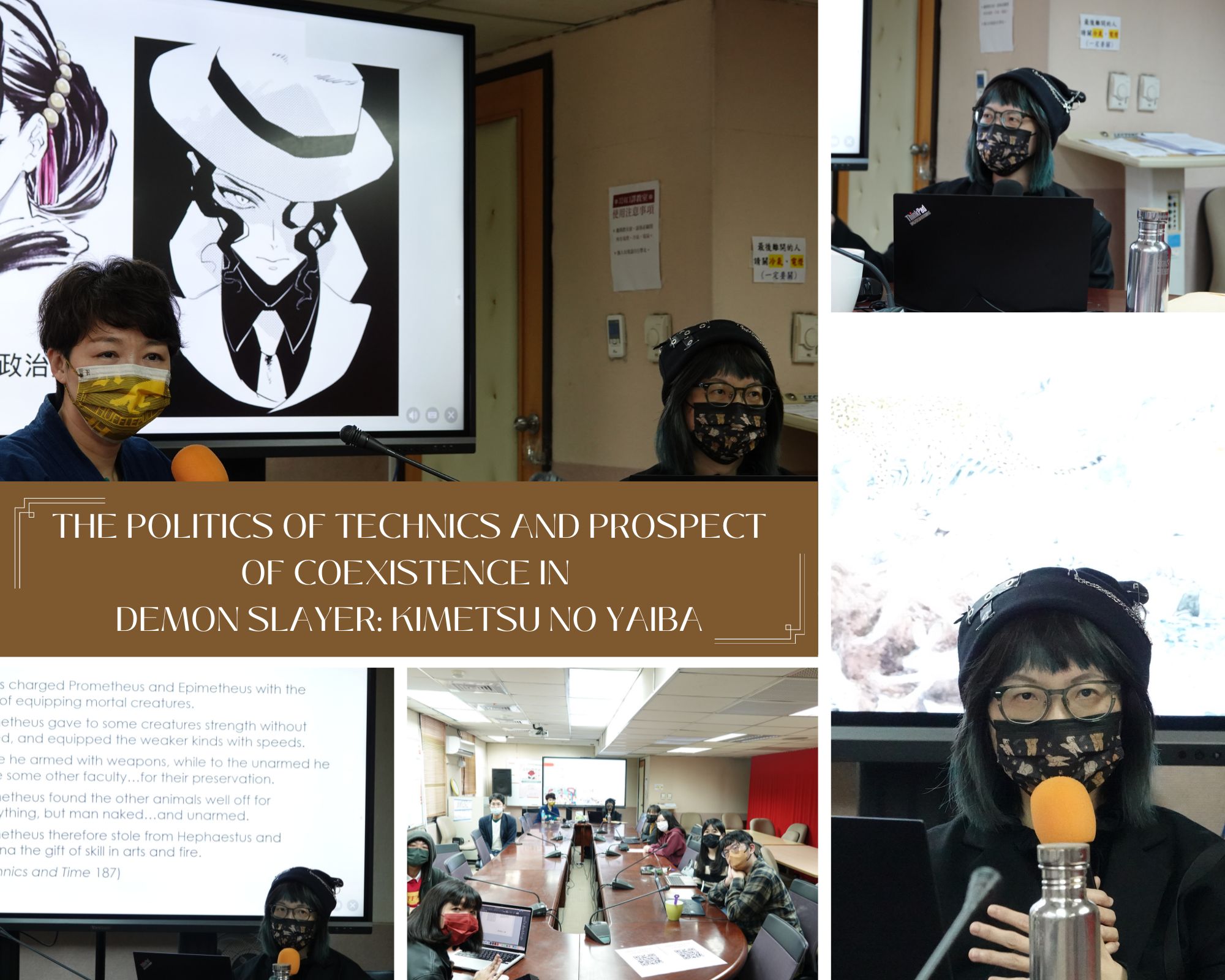The Eng-Lite Program Lecture Series: Talk No 4
Time:2023.01.06(Fri.)13:30-15:30
Topic:The Politics of Technics and Prospect of Coexistence in Demon Slayer: Kimetsu no Yaiba
Lecturer:Wan-shuan Lin , An Independent Scholar
Host:Wen-Hsun Chang, Associate Professor and Institute Director, Graduate Institute of Taiwan Literature, National Taiwan University
Venue: NTUGITL R324, Guo Qing Bldg.
By Conrad C. Carl

Are you ready to enter a world of demons and evil spirits? A time when supernatural beings and mortal humans were tied up in a century-long battle for survival and dominance? Then Demon Slayer: Kimetsu no Yaiba, the best-selling manga by Koyoharu Gotouge, might just be what you are looking for! That being said, what appears to be a rather simple and dualistic premise on the surface (i.e. demons and demon slayers, humans and nonhumans, and the supernatural and the natural), in fact turns out to be so nuanced and complex a world that it deserves further scrutiny. Independent scholar Jasmine Lin is not afraid of going into this thicket, whence she unfolds several incredibly rich arguments pertaining to some intertwining issues of health, technology and bodily transformations.
The story of Demon Slayer takes place in Taishō era Japan. The main narrative trajectory is, as the name suggests, the dispute between the Demon Slayer Corps, a group of demon hunters, and demons, former humans that now feed on humans for survival. But talking about this manga in terms of the conflicts between good and evil wouldn’t do it justice because what is foregrounded instead are tropes of peace, cooperation and collaboration. After introducing the audience to some more basic information about the manga, Dr. Lin turns directly to the first focal point of her talk: health, or rather the ever-changing configurations of what it means to be healthy and to own a healthy body. The way the manga challenges preconceptions of health is orchestrated specifically through the intake of all kinds of ability enhancing or altering substances. Lin shows how expectations of what is poison and what is remedy are played with constantly by the design of the diverse character arcs and their transformations throughout the manga. The examples Lin provides give insights into how these concepts are moulded into different shapes and forms. She contextualizes her arguments by referring, among others, to Bernard Stiegler, the influential French philosopher. By way of Stiegler, Lin revisits Derrida’s concept of pharmakon, which means either remedy, poison or scapegoat. In her succinct clarification, Demon Slayer develops intricate ways to enable its readers and viewers to experience precisely this complexity. From the health imageries in Demon Slayer, Lin extrapolates a utopian world-making attempt that creatively rethinks what health can mean in the present and future.
Technology, Dr. Lin asserts, is yet another pivotal motif of this manga that resists an overly simplified discourse. Stiegler famously argued that human evolution should be understood in terms of the development of different tools and technologies, and only through this development can our perception towards environment can be changed. Lin brings this into dialogue with hominization, a concept proposed by Peter Sloterdijk about human evolution. For Sloterdijk, hominization, is actually a drama of domestication because, with the discovery of tools, humans felt less dependent on the direct contact between their senses and environment, and the outward trajectory to the environment was thus turned inwards to the inner world of individuals or the groups they were a part of. Lin sheds even more light on the relationship between individuals and environment by referring to Umwelt, a concept raised by biologist Jakob Johann von Uexküll and later adopted to some extent by philosopher Martin Heidegger. Umwelt is the notion that animals, both human and non-human, have several subjective reference frames that are established with different kinds of environments. Different animals (or entities) engage with their environment differently; thus, they have different reference frames. In other words, perceptional differences structure the ways the world is made, whether it means humans, animals, demons or anything in between. And if we want to imagine a future of coexistence, the human perceptional framework should not be considered to be the highest authority in world-making.
Dr. Lin argues that Demon Slayer is a prime example of raising questions about the possibility of coexistence. As a cultural product it cultivates the sensibilities needed to fathom a de-anthropocentric world in which different life forms—in whichever way they might emerge—can flourish. In summary, then, Demon Slayer is a manga about the renegotiation of the relationship between humans and demons, or, in less marvelous terms, between humans and nonhumans or anything that is perceived as not quite human enough.
The discussion following the talk not only raised additional questions regarding the collective experience of COVID-19 and the relationship between the material and the immaterial, it also allowed Lin to emphasize again one very crucial point. Instead of considering Demon Slayer to be only fantastical, we should rather treat it as a concrete proposal for a future of coexistence, acknowledging its impetus to reconsider the value systems attached to different life forms which all too often serve as the basis of exploitation, discrimination and violence. Many thanks go to Dr. Jasmin Lin for this remarkable example of what it actually means to reconsider, rethink, and re-evaluate!
